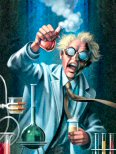 io9 has a fantastic piece that analyses the favoured subjects of investigation for mad scientists – tracking trends in 200 years of fictional evil research.
io9 has a fantastic piece that analyses the favoured subjects of investigation for mad scientists – tracking trends in 200 years of fictional evil research.
The researchers from io9’s underground science bunker scanned films and literature for depictions of the slightly unbalanced investigator to look at how research topics varied as fashions changed.
So what did we discover? First of all, mad scientists have obviously grown in popularity a great deal since the nineteenth century. Of all the sciences, biology seems to enjoy the most adherence from the maniacal – followed closely by its sister discipline, biotechnology. It’s interesting to note that big spike in mad scientists researching biology during the 1910s and 20s – this would have been the era when cinema and pulp fiction were gaining traction, and along with them “scientifiction” stories. It was also a time of great medical and biological experimentation in the west.
Coincidentally, today’s Guardian has an article on dispelling the image of the ‘boffin’ and the ‘mad scientist’ from the public’s mind to improve the image of science, noting that in the last decade Hollywood scientists are almost entirely depicted as beautiful competent young women.
If you work in cognitive science, of course, your research colleagues are probably entirely made up of beautiful competent young women, and I would like to make a stand for socially awkward not fully-in-touch-with-reality badly dressed male boffin.
Don’t get me wrong, I am frequently in awe of female cognitive scientists, but how many have burnt their ear with a soldering iron? A different but still valuable form of awe-inspiration I’m sure you’ll agree.
Link to io9 ‘Research areas of mad scientists, 1810-2010’ (via @NoaWG ).
Link to The Guardian ‘Who are you calling a boffin?’
One thought on “What do mad scientists study?”